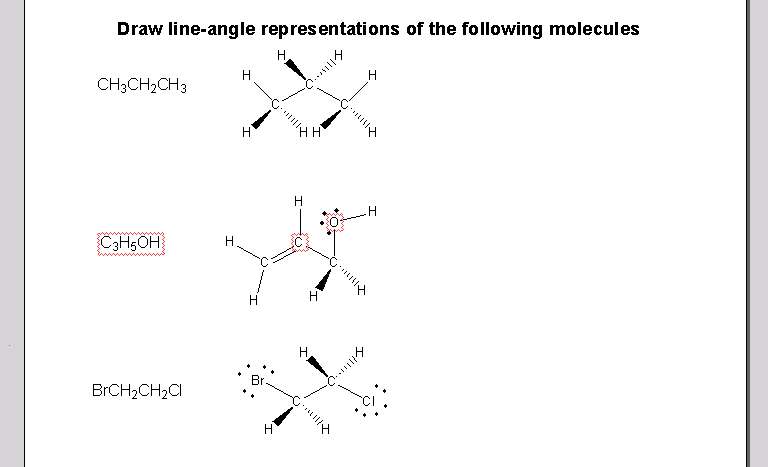This is an image of the portion of the assignment where we were asked to give line-angle drawings for several compounds. I was not familiar with the term line-angle drawing, so I assumed that I was supposed to give drawings that showed stereochemistry, with the substituents going into, or coming out of the page.

This is an image of the portion of the assignment after I learned what line-angle drawings were, and corrected my mistakes.
When I faced this assignment, I had never previously had an organic chemistry class, and this is a convention that is largely used/introduced in organic chemistry. Therefore, I could only guess at what line-angle could mean. I attacked the assignment with my misconception, only to learn the next day that I was completely wrong. With some assistance from Dr. Roberts, and my cohort-mates, I learned the CORRECT way to do line-angle drawings, and was able to go back to my assignment, and do them correctly. Previous to this program, the only drawings I had done were conventional Lewis Dot structures in my various General Chemistry classes in high school and college. I was not aware of other types of drawings for representing molecules. Now, not only am I able to do line-angle drawings, but I am also able to produce Haworth, Fischer, and Newman projections, among others. I also understand why different representations are better to use in different situations, and when looking at different aspects of the molecules represented. This was particularly important when I was writing my thesis, in which I used Haworth, Fischer, and line-angle representations for discussing the pectin molecule.
More important then the ability to use different methods for depicting molecules in different situations, learning these helped to solidify the truth of the basic scientific concept that there are no perfect models, only useful ones. The different methods of representing molecules have their individual inaccuracies and flaws, much like the different ways of thinking about a molecule and the "placement" of its atomic components has individual inaccuracies and flaws. For instance, using a Lewis Dot structure is useful for representing how many valence electrons are used in bonding, but inaccurately represents, for some molecules where the valence electrons come from, and inaccurately represents a static, non-moving nature to the valence electrons in a molecule's bonds. Using Haworth and Fischer projections are useful for indicating the locations of substituents on sugars, but are inadequate for depicting potential steric interactions, as can be seen in a chair/boat projection.
Baseline Evidence for Artifact #2:
Before starting MCEP, I had only had the application-required two collegiate-level chemistry courses. This meant that all I had ever covered was General Chemistry, and I confess to not having paid very close attention in the second of the two courses, which was the course that covered subjects such as hybridization. In addition, the amount of time that had passed since my high school chemistry course, that had also ventured into topics such as VSEPR, was so much that any details were, at best, fuzzy, and at worst completely lost in the fog of time. As a result, my understanding of atomic models stopped, largely at the Bohr quantum model. When discussing atomic structure with my General Physical Science class, I was relieved to know that the curriculum did not go beyond this model, because I would have been uncomfortable discussing any atomic model more advanced than that one.
These two images are pages from a problem set that I completed early in the Inorganic Chemistry class. The problems show representations of the regions where there is a probability greater than zero of locating an electron, and the regions where there is zero probability of locating an electron. In addition, the work shows representations of the Radial Function, which if calculated showing Schrodinger's wave equation will give us the density of electrons in respect to distance from the atom. The work also shows representations of the Radial Probability Function (R^2) which, if calculated, gives the probability of an electron being located at a particular point at a given distance from the atom.
Before MCEP, while I knew that there were other models that were useful for describing atoms and their electrons, I was unable to describe any that were more advanced than the Bohr quantum model, whereas now, I can describe several different atomic models. This supports further understanding of the basic scientific concept that I discuss above--there are no perfect models, only useful ones. For instance, even the Bohr model, with its limitations and inaccuracies in respect to understanding location of electrons is useful, due to its quantum nature, in understanding energy levels, with respect to electron levels. When combined with the electron-in-a-box model the quantum nature of the Bohr model helps us to QUANTIFY solutions to the Schrodinger wave equation by exacting limitations. In addition to these models, I also learned using HOMO/LUMO, ligand field theory, and crystal field theory are useful in various situations, as determined by the accuracies and/or limitations of each of those methods of describing electrons and their related energies. Finally, in addition to reinforcing the idea that there are no perfect models, the way in which the different atomic models developed, starting with Dalton and moving forward. Each was a development upon the previous ones that were not, in essence, wrong--just incomplete, revealing that the development of scientific thought is a constant process of testing and retesting "known" understandings, in order to improve and expand our breadth of knowledge.